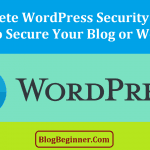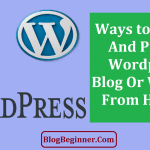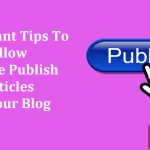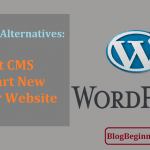Anything you put on the Internet is vulnerable. No matter how secure you think your website may be, there are many factors that make it vulnerable.
WordPress is one of the most used content management systems (CMS) all over the world.
It’s no wonder that it’s considered one of the most attacked CMS platforms.
As a website owner, you’re responsible for the security of your site.
If your WordPress site is hacked, your website’s reputation and revenue are also at risk.
Hackers can get important information and install or distribute harmful software and malware to your site and users.
The worst thing that you may experience is paying ransomware.
When hackers lock you out of your website, they may ask you to pay up just for you to get access to your website once more.
If you’re running a business website, you would need to give extra time and attention to the security of your WordPress site.
Luckily, there are many ways to prevent your website from being attacked.
Here are the essential security tips for your WordPress site.
Contents In Page
1. Regularly backup and update your site
Always backup your WordPress website since no one knows what may happen.
This will help you keep your site secured in safe mode.
There are various WordPress plugins you can use to backup your site.
Some plugins offer daily backups, spam filtering, one-click restore features, and a backup archive.
Besides backing up, you should also update your site regularly.
Every WordPress update comes with new bug fixes and security improvement.
Updating will also enable WordPress to discover malicious bugs, and it’ll put your site into a safe version.
Not updating will put your site at risk.
To update your WordPress site, go to the Dashboard.
You’ll find an announcement at the top of your page whenever a new version is released.
Simply click on the “Please update now” button to start updating your site in just a few seconds.
2. Make sure that user accounts are secured
User accounts that have access to your WordPress site open a greater window of vulnerability.
If hackers gain access to one of the accounts, particularly editor and admin accounts, they can create changes or even destroy your site.
To avoid this, ensure to only give other accounts the access needed.
If one user would only need to write content, you might consider giving his/her account an editor or contributor access.
Never give these types of users administration access.
Also, you need to assess the abilities of all the users that have access to your site.
Make sure that users with an editor or admin access are trained well enough to avoid mistakes and accidents.
You have an option to give temporary access to particular roles.
If you hired a contractor to work on your site for certain durations only, you can give them temporary access with a set timer.
After the timer has expired, they won’t have any access to the site anymore.
One more thing, your username must not be “admin”.
A major target for hacking is the WordPress login page.
Hackers try to access your site by guessing your username and password.
If you’ve already used the default username after installing WordPress, you can still change it.
In PHPMyAdmin, add an SQL query.
Make sure to change your username to something that’s difficult to crack like a combination of letters and numbers.
3. Create and use a strong password and set login attempt limitations
If your username is unique and difficult to guess, make sure that your password is strong as well.
Hackers can easily gain access to your site if your password is weak.
Avoid using passwords that are related to your personal life like birthdays, phone numbers, or address.
You must have a password that’s 10-15 characters long.
Also, use a combination of characters like “Tjs25TF#14” and make it a habit to change your password regularly.
Besides having a strong password, you should also limit the login attempts to your site.
Giving an infinite number of login tries to users will help hackers eventually guess your password.
Some hackers also use password-guessing bots.
These bots can log in using every character combination possible within a short amount of time.
Setting a limit to login attempts will prevent bots from getting through.
But, you’ll have to make sure that other users are aware that you’ve set a login attempt limit.
You must also implement an automatic log out for inactive users.
Sometimes, users wander away from their computers while still logged in.
When this happens, it’s easy for others to hijack their accounts by changing passwords and other details.
Installing and activating the Idle User Logout plugin will give you the authority to set an automatic logout duration for your users.
4. Only install and use trusted plugins
You may want to install a lot of different plugins for every problem you have on your site.
However, packing your site with too many plugins can be risky.
It can bloat your site and some unreliable plugins may get in your site.
Before installing plugins, check if they’re trustworthy.
Only get plugins from WordPress’s official website or interface.
Also, check a plugin’s reviews and star ratings.
If a plugin has negative reviews, you may want to think twice before installing it.
One more thing you have to look at is the last time a plugin was updated.
You should also check for its compatibility with your WordPress version.
Sometimes, plugins that haven’t been updated for some time aren’t that bad.
In these cases, look at recent reviews for confirmation that those old plugins are still working.
And of course, you should delete unused plugins and themes regularly.
A simple deactivated plugin may become a risk.
Always clean your plugin directory by only keeping plugins that you’re using at the moment.
Always check for new plugins that may be a better replacement to your currently-used plugins.
Check for plugins that are better supported, easier to maintain, and more secure.
Plugins that are already installed may also be updated if available.
Like most software, plugins are also prone to security breaches.
Always check if your plugins have updates to further prevent security attacks on your site.
5. Use a customized login URL
WordPress’s login page is easy to find using wp-admin or wp-login.php.
This is easily viewed by anyone in the site’s main URL. For example, “yourwebsite.com/wp-login.php”.
Your login page would be more secured if you change it to something unexpected.
Hackers would have a harder time guessing custom login URLs.
Using a plugin like iThemes Security, you can change your login URL to something else.
You can create a login URL that’s easy to remember for your users, but hard to crack by hackers like “yourwebsite.come/this_is_sparta”.
6. Upgrade your site to HTTPS
Upgrading your WordPress website to HTTPS will secure it against security attacks.
HTTPS keeps attackers away when you’re transferring data from server to server.
This is because HTTPS encrypts connections between your browser and the server.
It will also protect your website from risky hidden scripts on your system, as well as scripts that steal data through login forms.
WordPress has also made HTTPS websites get better rankings on Google’s search results.
So if you want to boost your website, upgrading to HTTPS is a must.
7. Choose a hosting server that’s most reliable
Despite doing everything necessary to secure your WordPress site, you’re still vulnerable to attacks if you don’t choose your hosting server wisely.
Many WordPress sites get hacked because of their hosting server’s security vulnerability.
This means that choosing the right web host providers doesn’t only affect your site’s performance, but its security as well.
If you opt for shared hosting, choose reliable servers like BlueHost or SiteGround.
These providers offer extra security features.
But, shared servers can include you in a cross-server contamination risk.
This happens when hackers gain access to a more vulnerable site and damage other websites that share the same spaces.
To prevent this from happening, you may want to consider VPS (Virtual Private Server) hosting or managed hosting. Your website will get its own space with loads of security features and unlimited bandwidth.
Getting a VPS hosting can be costly, but it’s sure to keep your website secured and performing well.
You must consider this, especially if your site has high traffic and loads.
Choose a managed host that can deliver the best service and solution that you need.
8. Install firewalls on your computer and WordPress site
Installing a firewall is one of the basic steps in protecting your computer from different threats online.
The idea of firewalls is that every questionable thing that tries to connect to your computer will be checked.
Once it’s proven to be suspicious, it’s kept away,
Having firewalls on your computer doesn’t directly affect your WordPress site, but it’s still an important factor.
You connect to the administration area of your website using your computer.
And if your computer’s security has been breached, the connection to your site will likely be vulnerable, too.
Apart from having firewalls on your computer, you may also install tools on your WordPress site for added security.
Having this kind of firewall prevents malware, hackers, and viruses from getting into your site.
9. Enable your site’s security scans
Security scanners for your WordPress site are like your computer’s anti-virus.
They go through your entire website to search for anything suspicious.
Once the scanners find suspicious content, they remove it immediately.
There are tons of free scanners that you can use to scan your website.
However, free scanners often provide only basic features.
You may need to sign up and pay for a premium account, which may help you make improvements on your site.
Luckily, there are plugins that can scan your site more thoroughly.
These also give you a report about your site’s weak spots.
Such plugins are regularly updated and function well on WordPress single installs.
Still, they should function on multisite networks.
10. Disable Directory Browsing and Indexing
Hackers can use your site’s directory browsing to search for any files that have security holes.
They can use these vulnerable files to access your site.
Other people may also look into your site’s files, discover your directory structure, or copy images.
Imagine that your house’s front door is always open. That gives thieves the idea of what they can steal from you.
This is why it’s important and recommended to disable your site’s directory browsing and indexing.
To do this, use FTP or cPanel’s file manager to connect to your website.
Then, look for the .htaccess file in your site’s root directory.
It’s a hidden file that can only be seen by enabling your FTP client to show all hidden files.
To edit your .htaccess file, download it onto your desktop and open it using Notepad or other text editors.
Finally, add the line “Options –Indexes” to the end of the .htaccess file.
Make sure that you save and upload the .htaccess file back to your site using the FTP client.
It’s as easy as that.
Doing this will disable your site’s directory index and people who will try to look for it will be redirected to the WordPress 404 page.
Conclusion:
There are still many ways to increase your WordPress website’s security.
But, these ten essential tips are a good start to having a well-secured site.
You’ve invested time, money, and effort in creating your website (or websites), so you must keep it from harm’s way.
If you feel that this is too much work for you, you can always hire other people to manage your website.
However, you need to thoroughly assess your WordPress site manager applicants.
Make sure that they can handle these security precautions.
Hiring someone who’s already an expert and can manage your site through coding is a plus.
Remember, prevention is key.
It’s easier to prevent security attacks than fixing a hacked WordPress website.
Just follow the steps above and continue to learn more about how to make your site more secure.








